A Superimposed QD-Based Optical Antenna for VLC: White LED Source
Abstract
:1. Introduction
2. Definition and Operating Principles of the LSC
3. LSC Monte Carlo Ray-Tracing Simulation
4. Results and Discussion
5. Conclusions
Author Contributions
Funding
Institutional Review Board Statement
Informed Consent Statement
Data Availability Statement
Conflicts of Interest
References
- Chamani, S.; Dehgani, R.; Rostami, A.; Mirtagioglu, H.; Mirtaheri, P. A Proposal for Optical Antenna in VLC Communication Receiver System. Photonics 2022, 9, 241. [Google Scholar] [CrossRef]
- Kafizov, A.; Elzanaty, A.; Alouini, M.-S. Probabilistic Shaping Based Spatial Modulation for Spectral-Efficient VLC. IEEE Trans. Wirel. Commun. 2022, in press. [Google Scholar] [CrossRef]
- Kirrbach, R.; Schneider, T.; Stephan, M.; Noack, A.; Faulwaßer, M.; Deicke, F. Total Internal Reflection Lens for Optical Wireless Receivers. Photonics 2022, 9, 276. [Google Scholar] [CrossRef]
- Tsai, T.-T.; Chow, C.-W.; Chang, Y.-H.; Jian, Y.-H.; Liu, Y.; Yeh, C.-H. 130-m Image sensor based Visible Light Communication (VLC) using under-sample modulation and spatial modulation. Opt. Commun. 2022, 519, 128405. [Google Scholar] [CrossRef]
- Najda, S.P.; Perlin, P.; Suski, T.; Marona, L.; Leszczyński, M.; Wisniewski, P.; Stanczyk, S.; Schiavon, D.; Slight, T.; Watson, M.A.; et al. GaN Laser Diode Technology for Visible-Light Communications. Electronics 2022, 11, 1430. [Google Scholar] [CrossRef]
- Peng, X.; Kong, L. Design and optimization of optical receiving antenna based on compound parabolic concentrator for indoor visible light communication. Opt. Commun. 2020, 464, 125447. [Google Scholar] [CrossRef]
- Li, J.; Xu, Y.; Shi, J.; Wang, Y.; Ji, X.; Ou, H.; Chi, N. A 2×2 imaging MIMO system based on LED Visible Light Communications employing space balanced coding and integrated PIN array reception. Opt. Commun. 2016, 367, 214–218. [Google Scholar] [CrossRef] [Green Version]
- Karunatilaka, D.; Zafar, F.; Kalavally, V.; Parthiban, R. LED Based Indoor Visible Light Communications: State of the Art. IEEE Commun. Surv. Tutor. 2015, 17, 1649–1678. [Google Scholar] [CrossRef]
- Saadallah, N.R.; Fathi, M.M.; Arwa, R. The efficiency of Li-Fi (light –Fidelity) security and data transmission compared to Wi-Fi. Mater. Today Proc. 2021, in press. [Google Scholar] [CrossRef]
- Song, S.-H.; Lin, D.-C.; Liu, Y.; Chow, C.-W.; Chang, Y.-H.; Lin, K.-H.; Wang, Y.-C.; Chen, Y.-Y. Employing DIALux to relieve machine-learning training data collection when designing indoor positioning systems. Opt. Express 2021, 29, 16887–16892. [Google Scholar] [CrossRef]
- Wu, Y.-C.; Chow, C.-W.; Liu, Y.; Lin, Y.-S.; Hong, C.-Y.; Lin, D.-C.; Song, S.-H.; Yeh, C.-H. Received-Signal-Strength (RSS) Based 3D Visible-Light-Positioning (VLP) System Using Kernel Ridge Regression Machine Learning Algorithm with Sigmoid Function Data Preprocessing Method. IEEE Access 2020, 8, 214269–214281. [Google Scholar] [CrossRef]
- Shen, C.; Guo, Y.; Oubei, H.M.; Ng, T.K.; Liu, G.; Park, K.; Ho, K.T.; Alouini, M.-S.; Ooi, B.S. 20-meter underwater wireless optical communication link with 15 Gbps data rate. Opt. Express 2016, 24, 25502–25509. [Google Scholar] [CrossRef] [PubMed]
- Mukherjee, M. Wireless Communication-Moving from RF to Optical; IEEE: Piscataway, NJ, USA, 2016. [Google Scholar]
- Ergul, O.; Dinc, E.; Akan, O.B. Communicate to illuminate: State-of-the-art and research challenges for visible light communications. Phys. Commun. 2015, 17, 72–85. [Google Scholar] [CrossRef] [Green Version]
- Hosseinzadeh, A.; Zhou, J.L.; Altaee, A.; Li, D. Machine learning modeling and analysis of biohydrogen production from wastewater by the dark fermentation process. Bioresour. Technol. 2022, 343, 126111. [Google Scholar] [CrossRef]
- Hosseinzadeh, A.; Zhou, J.L.; Li, X.; Afsari, M.; Altaee, A. Techno-economic and environmental impact assessment of hydrogen production processes using bio-waste as renewable energy resource. Renew. Sustain. Energy Rev. 2022, 156, 111991. [Google Scholar] [CrossRef]
- Hosseinzadeh, A.; Zhou, J.L.; Navidpour, A.H.; Altaee, A. Progress in osmotic membrane bioreactors research: Contaminant removal, microbial community and bioenergy production in wastewater. Bioresour. Technol. 2021, 330, 124998. [Google Scholar] [CrossRef]
- Gao, M.; Lan, T.; Zhao, T.; Zhang, Y.; Cui, Z.; Ni, G. Research on field of view of optical receiving antenna based on indoor visible light communication system. In Proceedings of the 2015 International Conference on Optical Instruments and Technology: Optoelectronic Devices and Optical Signal Processing, Beijing, China, 5 August 2015; p. 96190I. [Google Scholar]
- Huang, N.; Wang, X.; Chen, M. Transceiver Design for MIMO VLC Systems with Integer-Forcing Receivers. IEEE J. Sel. Areas Commun. 2017, 36, 66–77. [Google Scholar] [CrossRef]
- Wu, C.; Lai, C.-F. A survey on improving the wireless communication with adaptive antenna selection by the intelligent method. Comput. Commun. 2022, 181, 374–403. [Google Scholar] [CrossRef]
- Wang, D.; Lan, T. Design of a gradient-index lens with a compound parabolic concentrator shape as a visible light communication receiving antenna. Appl. Opt. 2018, 57, 1510–1517. [Google Scholar] [CrossRef]
- Xiang, L.; Tian, L.; Yun, W.; Long-Hui, W. Design and study of Fresnel lens for an antenna in the indoor visible light communication system. Acta Phys. Sin. 2015, 64, 24201. [Google Scholar] [CrossRef]
- Yun, W.; Tian, L.; Xiang, L.; Zhen-Min, S.; Guo-Qiang, N. Design research and performance analysis of compound parabolic concentrators as optical antennas in visible light communication. Acta Phys. Sin. 2015, 64, 124212. [Google Scholar] [CrossRef]
- Plastikov, A.N. Multiple beam bifocal reflector antenna design with front-fed offset Gregorian configuration. In Proceedings of the 8th European Conference on Antennas and Propagation (EuCAP 2014), The Hague, The Netherlands, 6–11 April 2014; pp. 418–422. [Google Scholar] [CrossRef]
- Umair, M.; Akisawa, A.; Ueda, Y. Simulation study of continuous solar adsorption refrigeration system driven by the com-pound parabolic concentrator. Renew. Energy 2014, 7, 1–12. [Google Scholar]
- Manousiadis, P.; Rajbhandari, S.; Mulyawan, R.; Vithanage, D.A.; Chun, H.; Faulkner, G.; O’Brien, D.C.; Turnbull, G.; Collins, S.; Samuel, I. Wide field-of-view fluorescent antenna for visible light communications beyond the étendue limit. Optica 2016, 3, 702–706. [Google Scholar] [CrossRef]
- Portnoi, M.; Haigh, P.A.; Macdonald, T.J.; Ambroz, F.; Parkin, I.P.; Darwazeh, I.; Papakonstantinou, I. Bandwidth limits of luminescent solar concentrators as detectors in free-space optical communication systems. Light. Sci. Appl. 2021, 10, 3. [Google Scholar] [CrossRef] [PubMed]
- Riaz, A.; Faulkner, G.; Collins, S. A Fluorescent Antenna for White Light Visible Light Communications. In Proceedings of the 2019 Global LIFI Congress (GLC), Paris, France, 12–13 June 2019; pp. 1–4. [Google Scholar] [CrossRef]
- Shu, J.; Zhang, X.; Wang, P.; Chen, R.; Zhang, H.; Li, D.; Zhang, P.; Xu, J. Monte-Carlo simulations of optical efficiency in luminescent solar concentrators based on all-inorganic perovskite quantum dots. Phys. B Condens. Matter 2018, 548, 53–57. [Google Scholar] [CrossRef]
- El-Bashir, S.M.; Al-Harbi, F.F.; Elburaih, H.; Al-Faifi, F.; Yahia, I.S. Red photoluminescent PMMA nanohybrid films for modifying the spectral distribution of solar radiation inside greenhouses. Renew. Energy 2016, 85, 928–938. [Google Scholar] [CrossRef]
- Zhao, F.; Cambié, D.; Janse, J.; Wieland, E.W.; Kuijpers, K.P.L.; Hessel, V.; Debije, M.G.; Noël, T. Scale-up of a Luminescent Solar Concentrator-Based Photomicroreactor via Numbering-up. ACS Sustain. Chem. Eng. 2018, 6, 422–429. [Google Scholar] [CrossRef]
- Bimber, O.; Koppelhuber, A. Toward a Flexible, Scalable, and Transparent Thin-Film Camera. Proc. IEEE 2017, 105, 960–969. [Google Scholar] [CrossRef]
- Chazot, C.A.C.; Nagelberg, S.; Rowlands, C.J.; Scherer, M.R.J.; Coropceanu, I.; Broderick, K.; Kim, Y.; Bawendi, M.G.; So, P.T.C.; Kolle, M. Luminescent surfaces with tailored angular emission for compact dark-field imaging devices. Nat. Photon. 2020, 14, 310–315. [Google Scholar] [CrossRef]
- Peyronel, T.; Quirk, K.J.; Wang, S.C.; Tiecke, T.G. Luminescent detector for free-space optical communication. Optica 2016, 3, 787–792. [Google Scholar] [CrossRef]
- Krumer, Z.; Pera, S.J.; van Dijk-Moes, R.J.; Zhao, Y.; de Brouwer, A.F.; Groeneveld, E.; van Sark, W.G.; Schropp, R.E.; Donegá, C.D.M. Tackling self-absorption in luminescent solar concentrators with type-II colloidal quantum dots. Sol. Energy Mater. Sol. Cells 2013, 111, 57–65. [Google Scholar] [CrossRef] [Green Version]
- Leow, S.W.; Corrado, C.; Osborn, M.; Isaacson, M.; Alers, G.; Carter, S.A. Analyzing luminescent solar concentrators with front-facing photovoltaic cells using weighted Monte Carlo ray tracing. J. Appl. Phys. 2013, 113, 214510. [Google Scholar] [CrossRef] [Green Version]
- Li, S.; Liu, H.; Chen, W.; Zhoua, Z.; Wub, D.; Luc, R.; Zhaoa, B.; Hao, J.; Yangc, L.; Yanga, H.; et al. Low reabsorption and stability enhanced luminescent solar concentrators based on silica encapsulated quantum rods. Sol. Energy Mater. Sol. Cells 2020, 206, 110321. [Google Scholar] [CrossRef]
- Mirzaei, M.R.; Rostami, A.; Matloub, S.; Mirtaghizadeh, H. Ultra-high-efficiency luminescent solar concentrator using superimposed colloidal quantum dots. Opt. Quantum Electron. 2020, 52, 327. [Google Scholar] [CrossRef]
- Liao, L.; Lin, T.; Bin, X.; Quan, K.; Zhang, L.; Zeng, R.; Zhai, J.; Mo, X.; Zhao, J. Reabsorption-free luminescent solar concen-trator based on environmentally friendly cesium copper halide nanocrystals. J. Lumin. 2022, 248, 118927. [Google Scholar] [CrossRef]
- Hernández-Rodríguez, M.A.; Correia, S.F.H.; Ferreira, R.A.S.; Carlos, L.D. A perspective on sustainable luminescent solar concentrators. J. Appl. Phys. 2022, 131, 140901. [Google Scholar] [CrossRef]
- Kataria, V.; Mehta, D.S. Shape engineered Y2O3: Eu3+ nanodots for Stokes shifting high-efficiency PMMA based transparent luminescent solar concentrator. J. Lumin. 2022, 248, 118955. [Google Scholar] [CrossRef]
- Gu, G.; Zheng, Z.; Zhang, H.; Zhang, Y.; Gan, Z.; Huang, R.; Zhang, X. Re-absorption-free perovskite quantum dots for boosting the efficiency of the luminescent solar concentrator. J. Lumin. 2022, 248, 118963. [Google Scholar] [CrossRef]
- Wang, W.; Ho, J.C. Luminescent concentrators enable highly efficient and broadband photodetection. Light. Sci. Appl. 2022, 11, 125. [Google Scholar] [CrossRef]
- El-Bashir, S.; Barakat, F.; AlSalhi, M. Metal-enhanced fluorescence of mixed coumarin dyes by silver and gold nanoparticles: Towards plasmonic thin-film luminescent solar concentrator. J. Lumin. 2013, 143, 43–49. [Google Scholar] [CrossRef]
- Nikolaidou, K.; Sarang, S.; Hoffman, C.; Mendewala, B.; Ishihara, H.; Lu, J.Q.; Ilan, B.; Tung, V.; Ghosh, S. Hybrid Perovskite Thin Films as Highly Efficient Luminescent Solar Concentrators. Adv. Opt. Mater. 2016, 4, 2126–2132. [Google Scholar] [CrossRef]
- Meinardi, F.; Colombo, A.; Velizhanin, K.A.; Simonutti, R.; Lorenzon, M.; Beverina, L.; Viswanatha, R.; Klimov, V.; Brovelli, S. Large-area luminescent solar concentrators based on ‘Stokes-shift-engineered’ nanocrystals in a mass-polymerized PMMA matrix. Nat. Photon. 2014, 8, 392–399. [Google Scholar] [CrossRef]
- Delgado-Sanchez, J.-M. Luminescent solar concentrators: Photo-stability analysis and long-term perspectives. Sol. Energy Mater. Sol. Cells 2019, 202, 110134. [Google Scholar] [CrossRef]
- Liu, C.; Li, B. Multiple dyes containing luminescent solar concentrators with enhanced absorption and efficiency. J. Opt. 2015, 17, 025901. [Google Scholar] [CrossRef]
- Nolasco, M.M.; Vaz, P.M.; Freitas, V.T.; Lima, P.P.; André, P.S.; Ferreira, R.A.S.; Vaz, P.D.; Ribeiro-Claro, P.; Carlos, L.D. Engineering highly efficient Eu(iii)-based tri-ureasil hybrids toward luminescent solar concentrators. J. Mater. Chem. A 2013, 1, 7339–7350. [Google Scholar] [CrossRef]
- Zhao, H.; Zhou, Y.; Benetti, D.; Ma, D.; Rosei, F. Perovskite quantum dots integrated with large-area luminescent solar concentrators. Nano Energy 2017, 37, 214–223. [Google Scholar] [CrossRef]
- Papakonstantinou, I.; Portnoi, M.; Debije, M.G. The Hidden Potential of Luminescent Solar Concentrators. Adv. Energy Mater. 2021, 11, 2002883. [Google Scholar] [CrossRef]
- Mirzaei, M.R.; Rostami, A.; Matloub, S.; Nazari, M. Design and optimization of graphene quantum dot-based luminescent solar concentrator using Monte-Carlo simulation. Energy Built Environ. 2021, in press. [Google Scholar] [CrossRef]
- Gupta, P.; Pandey, A.; Vairagi, K.; Mondal, S.K. Solving Fresnel equation for refractive index using reflected optical power obtained from Bessel beam interferometry. Rev. Sci. Instrum. 2019, 90, 015110. [Google Scholar] [CrossRef]
- El-Badry, Y.A.; Mahmoud, K. Optical study of a static benzoxazinone derivative doped poly (vinyl) pyrrolidone—Poly(vinyl) alcohol blend system. Spectrochim. Acta A Mol. Biomol. Spectrosc. 2019, 219, 307–312. [Google Scholar] [CrossRef]
- Mortimer, R.J.; Varley, T.S. Quantification of colour stimuli through the calculation of CIE chromaticity coordinates and luminance data for application to insitu colorimetry studies of electrochromic materials. Displays 2011, 32, 35–44. [Google Scholar] [CrossRef] [Green Version]

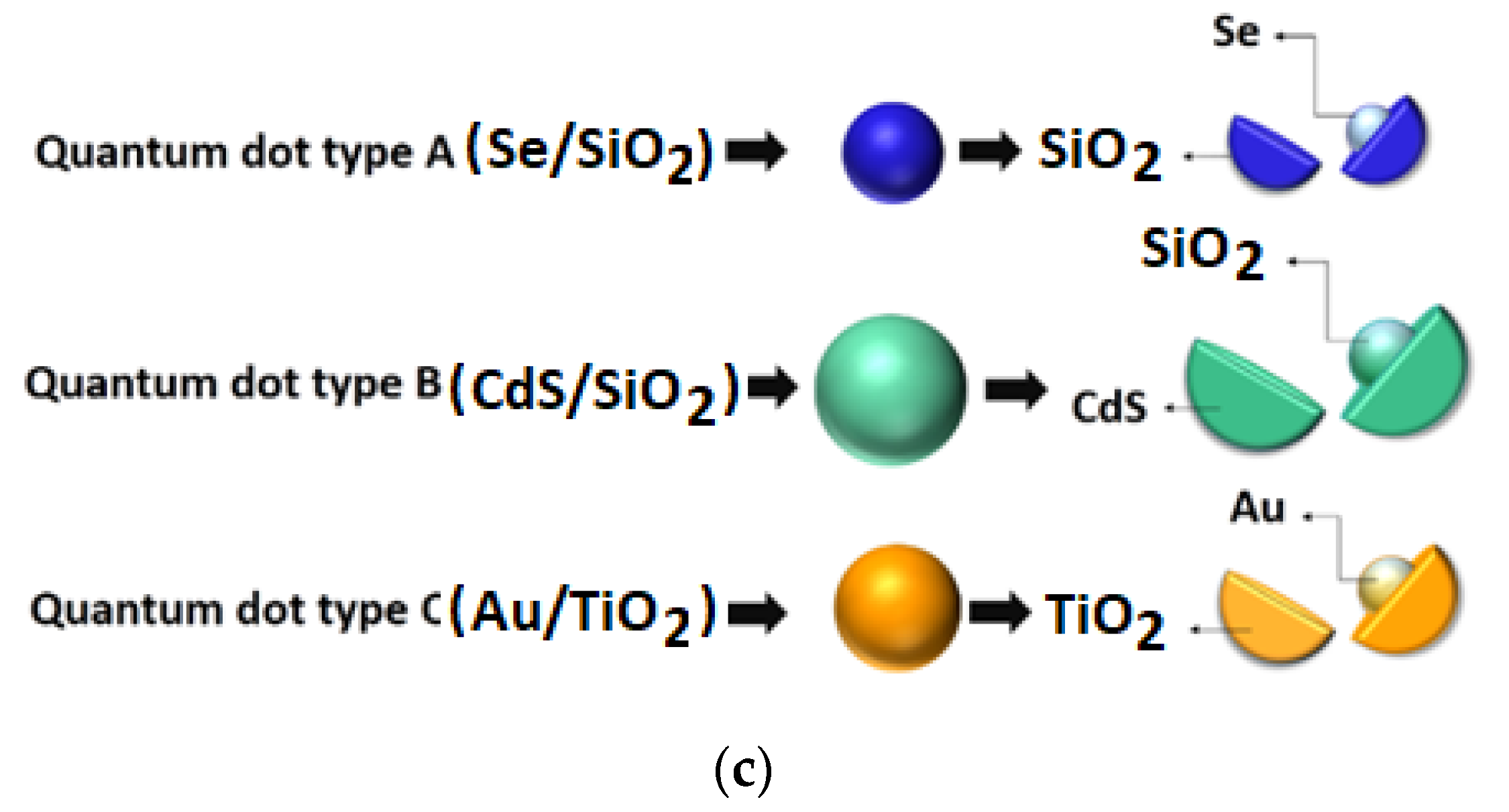



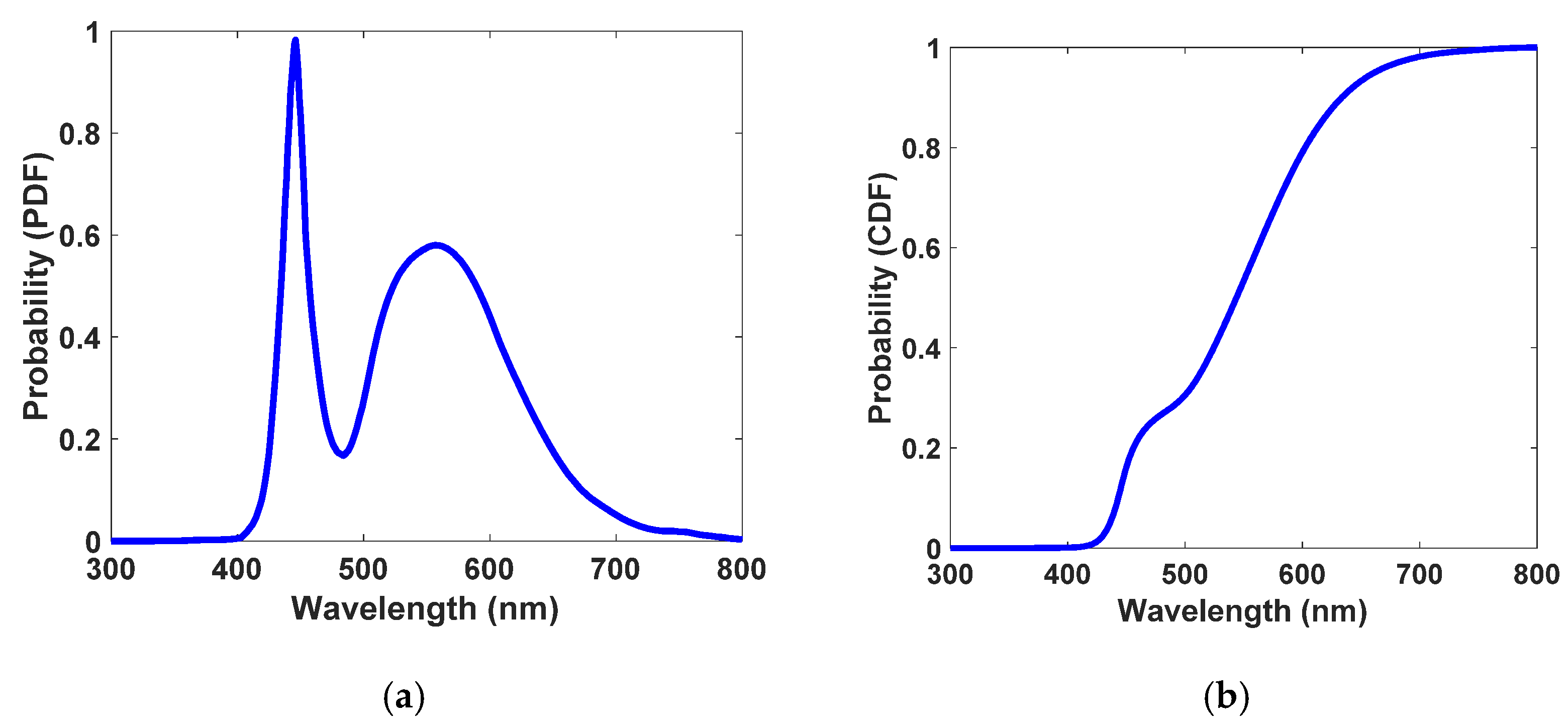
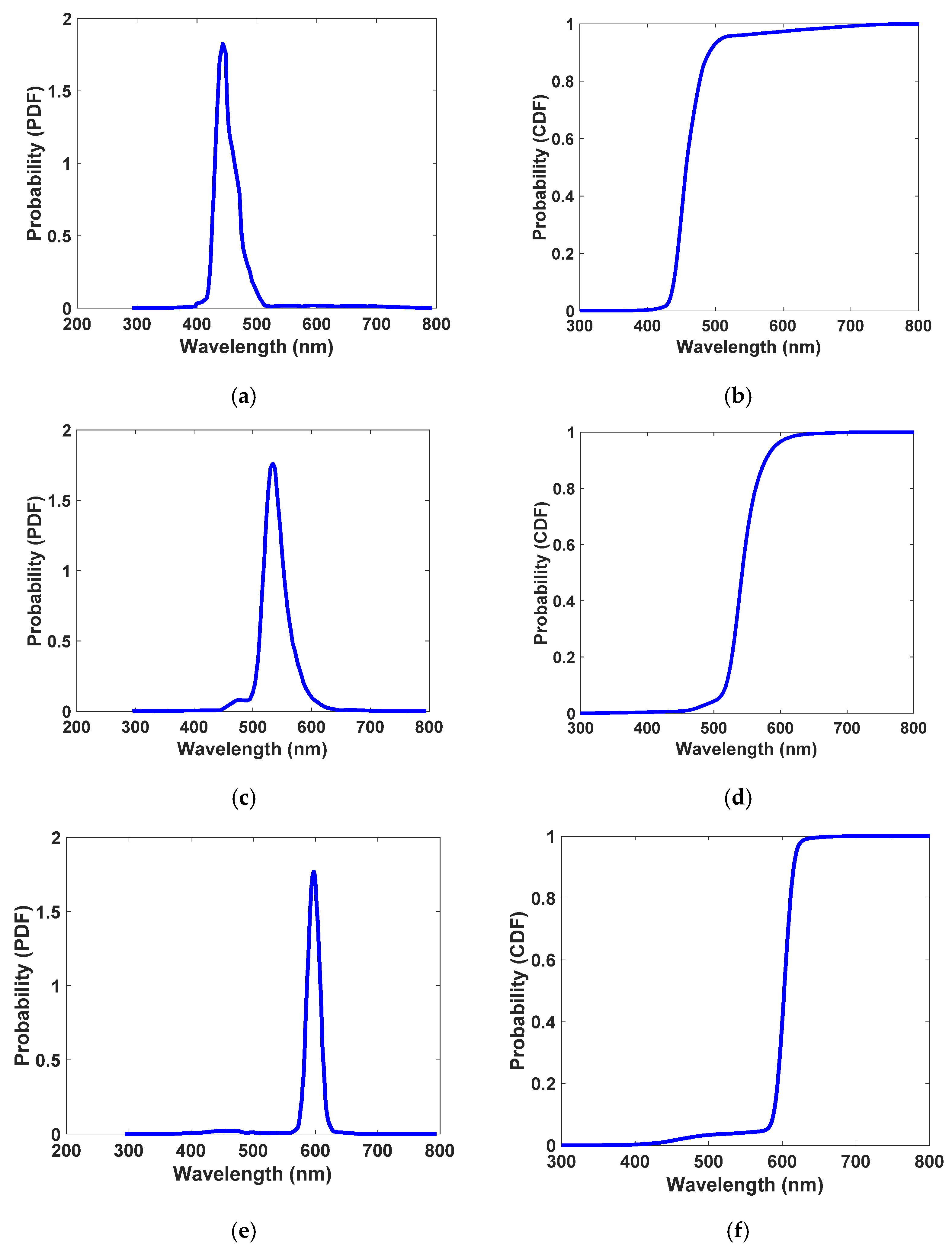
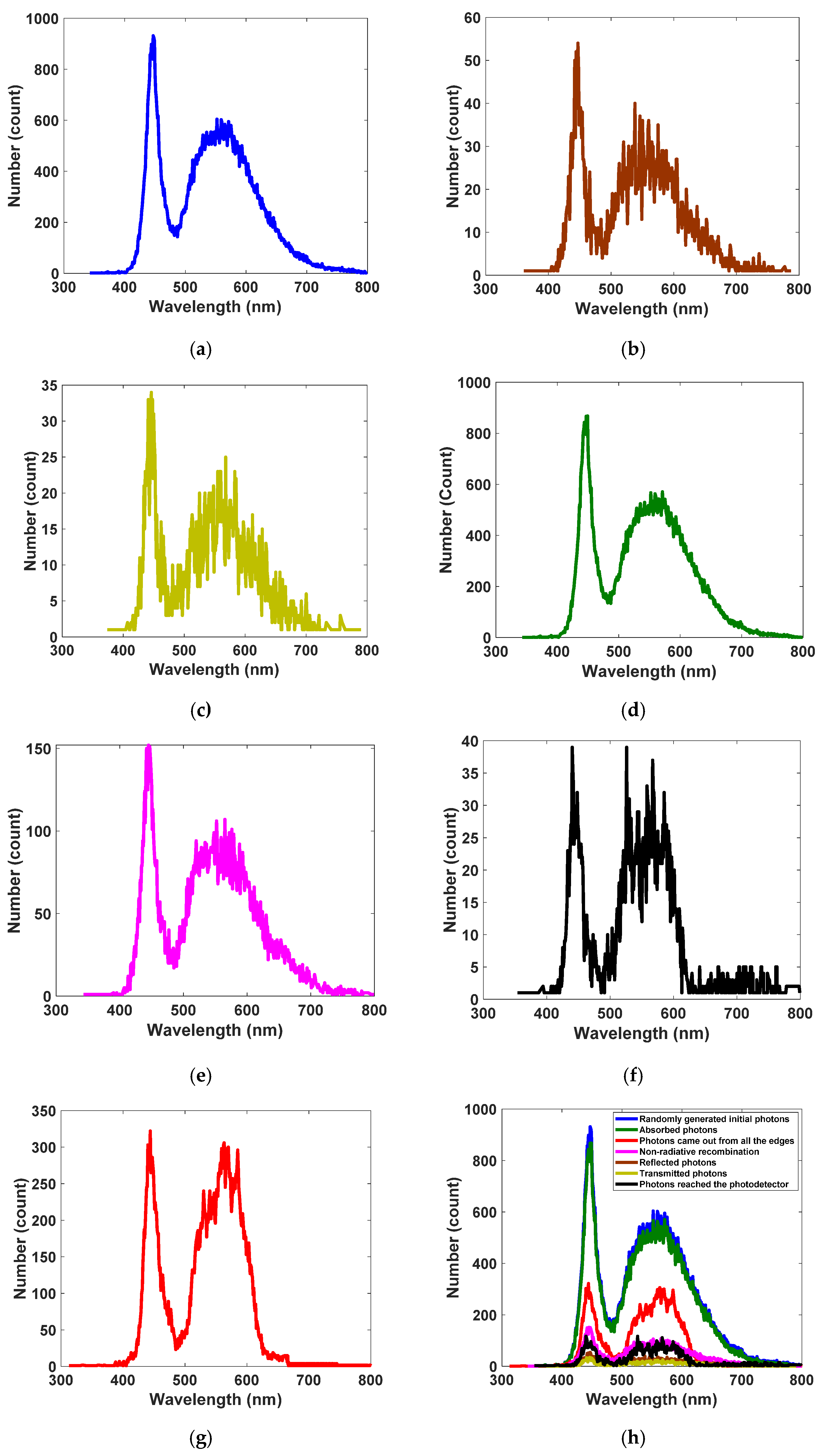
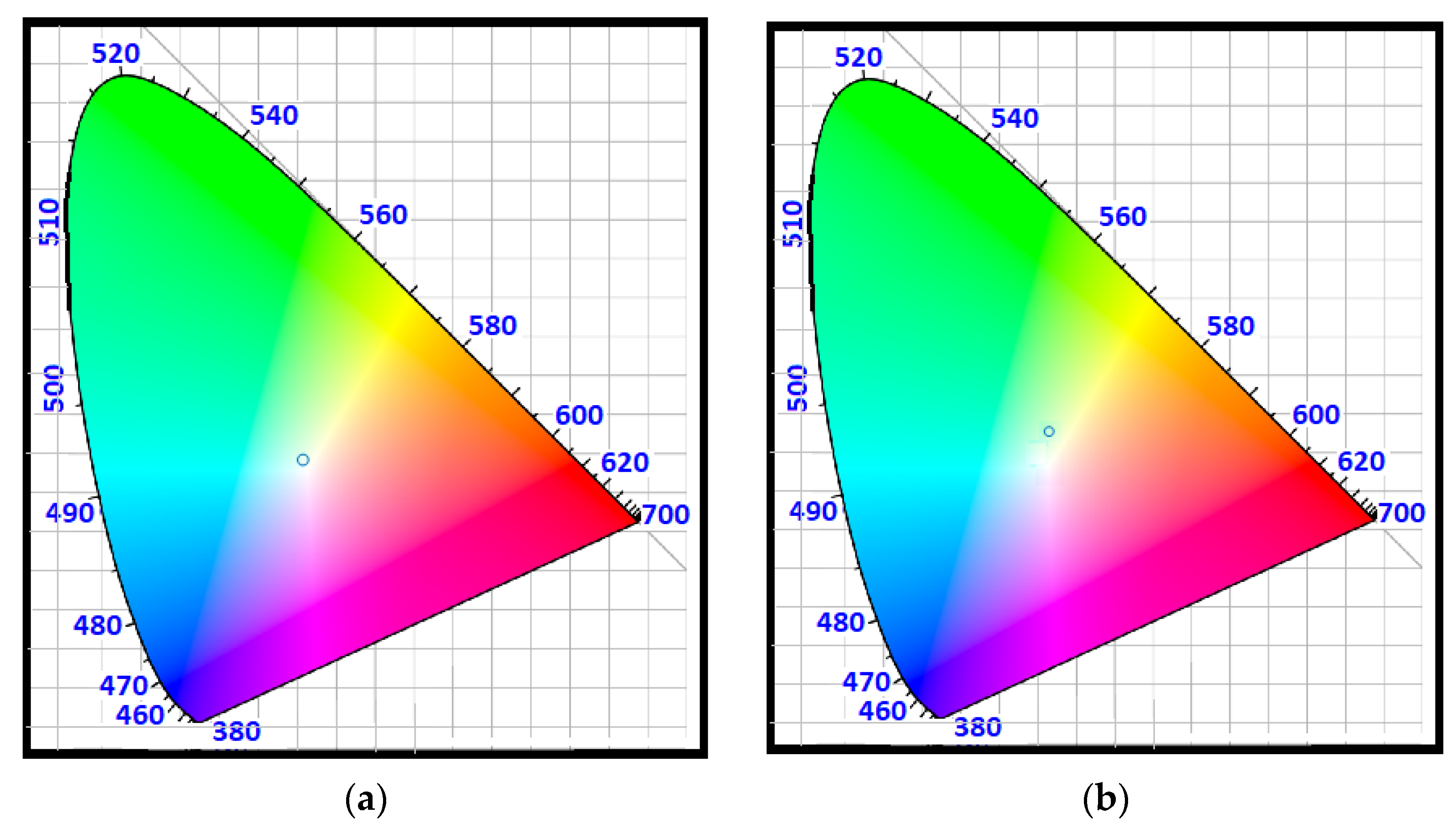
Publisher’s Note: MDPI stays neutral with regard to jurisdictional claims in published maps and institutional affiliations. |
© 2022 by the authors. Licensee MDPI, Basel, Switzerland. This article is an open access article distributed under the terms and conditions of the Creative Commons Attribution (CC BY) license (https://creativecommons.org/licenses/by/4.0/).
Share and Cite
Chamani, S.; Rostami, A.; Mirtaheri, P. A Superimposed QD-Based Optical Antenna for VLC: White LED Source. Nanomaterials 2022, 12, 2573. https://doi.org/10.3390/nano12152573
Chamani S, Rostami A, Mirtaheri P. A Superimposed QD-Based Optical Antenna for VLC: White LED Source. Nanomaterials. 2022; 12(15):2573. https://doi.org/10.3390/nano12152573
Chicago/Turabian StyleChamani, Shaghayegh, Ali Rostami, and Peyman Mirtaheri. 2022. "A Superimposed QD-Based Optical Antenna for VLC: White LED Source" Nanomaterials 12, no. 15: 2573. https://doi.org/10.3390/nano12152573





